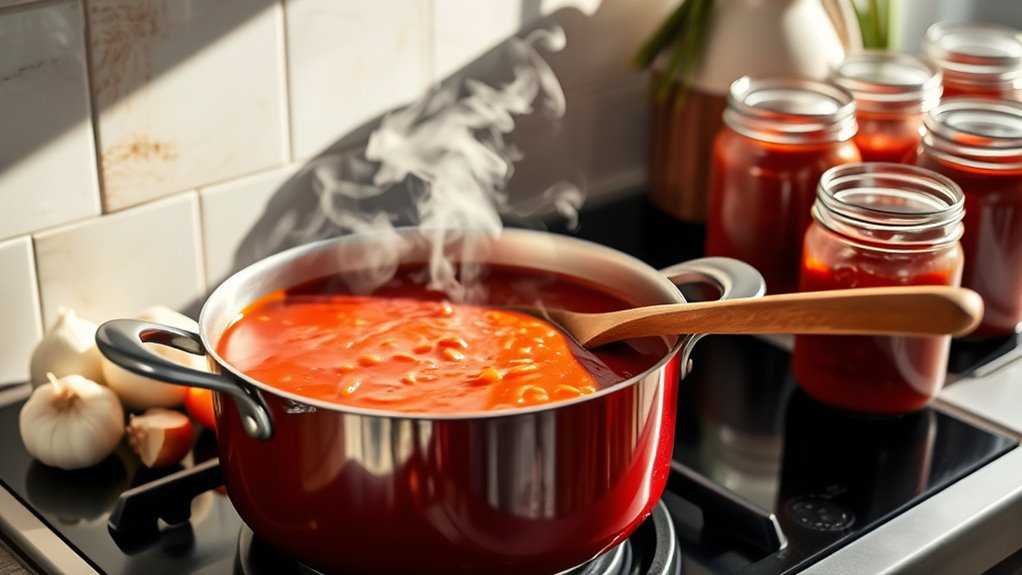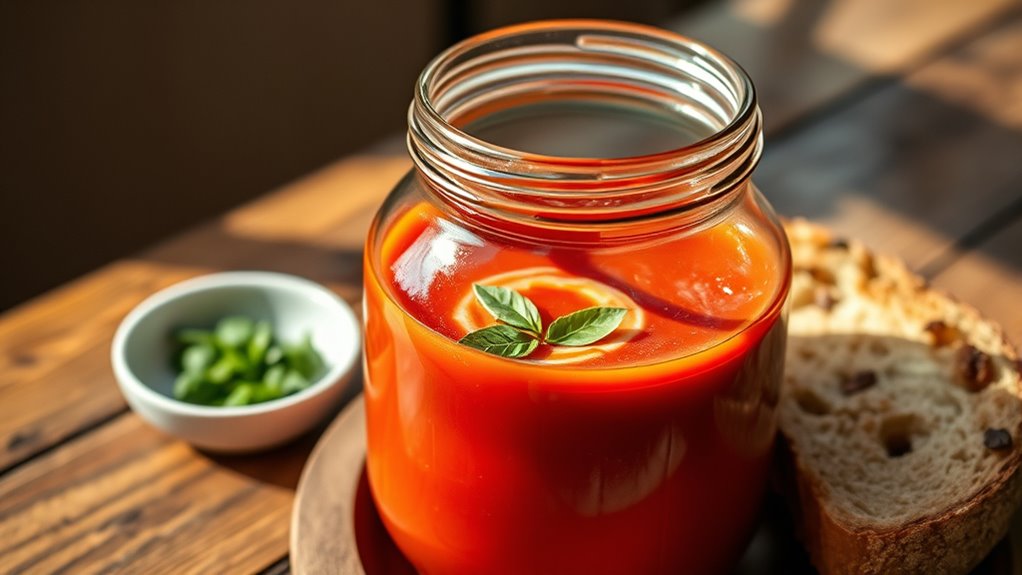To can tomato soup, start with 2.5 lb of fresh tomatoes per quart, plus 1 large onion, 2–3 cloves garlic, 2 tbsp olive oil, and 1–2 tsp salt. Sauté onions and garlic, add crushed tomatoes and stock, simmer gently, then season with salt and a touch of sugar. Use clean canning jars, a pressure canner, and a wide-mouth funnel to fill. Process per tested times, seal jars, label, and store cool and dark—more steps await if you keep exploring.
Ingredients and Quantity

For this Tomato Soup Recipe, you’ll need a well-balanced set of ingredients and quantities to guarantee a smooth, flavorful result. You’re choosing tomato varieties with care, balancing sweetness and acidity, then aligning weights and volumes precisely for consistency. Consider ripe, flavorful options and plan for about 2.5 pounds of tomatoes per quart of soup. Include onions, garlic, olive oil, stock, salt, and a touch of sugar, measured to a precise gram or teaspoon. Canning methods are kept separate from this subtopic, so focus on quantities here.
| Ingredient | Quantity | Notes |
|---|---|---|
| Tomatoes | 2.5 lb per quart | Fresh, ripe |
| Onion | 1 large | Diced |
| Garlic | 2–3 cloves | Minced |
| Olive oil | 2 tbsp | For sauté |
| Salt | 1–2 tsp | To taste |
Preparations

The preparations start with organizing and measuring every component to guarantee consistency: rinse the tomatoes, tom them roughly, and gather the onions, garlic, olive oil, stock, salt, and sugar so nothing is left to guess. You’ll refine preparation techniques by selecting ripe, unblemished fruit and batching aromatics for even flavor. Establish a calm mise en place, label jars, and confirm quantities before you begin. With ingredient selection in mind, heat oil gently to awaken aroma without scorching. Add onions and garlic, sweating until translucent, then introduce tomatoes and stock. Maintain steady heat, adjust salt and sugar to taste, and skim as needed. This mindful process supports reliable canning outcomes while preserving freedom to taste.
Kitchen tools or Kitchenware Required

To prep properly, gather the tools that will support clean, efficient cooking and consistent results. You’ll want reliable, dedicated equipment that minimizes risk and maximizes success. Start with canning jars and lids that are labeled for pressure canning, plus a sturdy jar lifter for safe handling. A pressure cooker is essential for safety-tested processing. Have a wide-mouth funnel, a ladle, and a magnetic wand for easy metal tool access. Keep a timer, jar bands, and a boil-safe catcher nearby. For organization, the table below adds clarity:
| Tool | Purpose |
|---|---|
| Canning jars | Storage and processing |
| Pressure cooker | Safe, efficient processing |
How to Cook

- Heat a pot over medium heat.
- Add olive oil and onions, sauté until soft and translucent.
- Add garlic briefly, stirring to combine.
- Pour in crushed tomatoes and stock, stirring gently to integrate flavors without splashing.
- Maintain steady heat to bring mixture to a gentle simmer, avoiding boiling.
- Season with salt, pepper, and a pinch of sugar if needed, tasting and adjusting as you go.
- Simmer slowly, allowing flavors to deepen and reduce slightly for body.
- Whisk in a touch of cream for silkiness, if desired.
- Focus on enhancing flavor through careful seasoning, avoiding excess salt or artificial additives.
- Finish with a smooth, balanced base ready for canning.
How to Serve

Pour a hot bowl of tomato soup into your favorite mug or shallow bowl, and set it on a warm plate to catch any drips. You’ll serve it as a welcome starter or light main, aligned with your goal of practical nourishment. Begin with a steady aroma, then present the liquid with clean lines and minimal clutter. Serving suggestions include a crusty slice of bread or a simple grilled cheese, arranged within easy reach. Consider bowls with stable bases and unobtrusive rims to maintain focus on color and texture. Garnish ideas should be subtle: a light whisper of fresh herbs, a drizzle of olive oil, or a pinch of smoked paprika, applied sparingly. Keep the presentation calm, functional, and inviting for confident serving.
Tips
When you move from serving tips to practical guidance, you’ll want a few steady touchpoints to keep tomato soup tasting its best. This section focuses on canning safety and storage tips to maintain quality and minimize risk.
- Follow tested guidelines precisely, especially processing times and jar seals, to guarantee safety and shelf stability.
- Label and date every jar, store in a cool, dark place, and rotate stock so older batches are used first.
- Inspect jars before use; discard bulged lids, leaks, or signs of spoilage, and refrigerate after opening.
Food Value and Benefit
Tomato soup is a nutritious and low-calorie prepared dish that offers several health benefits, making it an excellent choice for balanced meals.
Benefits of eating tomato soup:
- Supports digestion due to its fiber content
- Provides antioxidant support with vitamins A and C
- Aids immune function and promotes healthy skin
- Offers a satisfying and flavorful option without excessive calories
- Can be part of a heart-healthy diet when sodium levels are monitored
Vitamins and minerals in tomato soup:
- Vitamin A
- Vitamin C
- Potassium
- Folate
When choosing or preparing tomato soup, pay attention to sodium levels as they can vary. Proper canning and storage help preserve nutrient quality and ensure safety. Store opened jars in the refrigerator and consume promptly to maintain freshness.
Frequently Asked Questions
What Is the Best Tomato Variety for Canning?
You’ll get the best canning results with Roma tomatoes, though Beefsteak tomatoes can work in a pinch; aim for ripe, firm fruit, remove seeds when needed, and adjust acidity carefully for safe, reliable preserves.
How Long to Store Unopened Tomato Soup Canning Jars?
“Time is of the essence,” you know, storage duration for unopened tomato soup jars is about 12 to 18 months, depending on seal integrity. In practice, check shelf life and rotate; avoid compromised jars and label with dates.
Can I Use Sugar Substitutes in Tomato Soup Canning?
Yes, you can try sugar alternatives, but monitor flavor balance carefully. Use moderate amounts to avoid jeopardizing safety or texture, and remember flavor enhancement matters; taste thoroughly, adjust gradually, and follow tested canning guidelines for best results.
Are There Altitude Adjustments for Canning Tomato Soup?
Altitude adjustments exist for tomato soup canning; follow canning guidelines precisely. Imagine a case study where you’re at high altitude adjusting processing time. You should: measure altitude, adjust times, and reseal with careful, cautious method.
Is Pressure Canning Necessary for Tomato Soup?
Pressure canning isn’t strictly necessary for tomato soup at home; you can water-bath if you guarantee proper acidity. But for safety, monitor pressure canning guidelines, since pressure safety and soup acidity affect reliable preservation.
